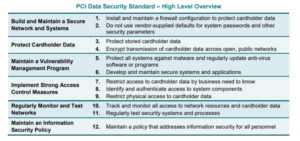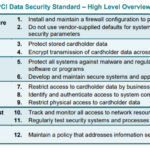As an enterprise dealing with digital financial transactions, adhering to the Payment Card Industry Data Security Standard (PCI-DSS) is crucial for both ethical and legal reasons. In the article, “Understanding the Documentation Required for PCI-DSS Compliance”, you’ll discover the necessary paperwork and protocols involved in becoming fully compliant with these industry standards. We discuss the specific documentation required by PCI-DSS, enabling your firm to navigate these stringent regulations with competence and ease.

Understanding PCI-DSS
As a business dealing with credit card information, it’s imperative to understand and comply with relevant standards designed to ensure the safety and security of this sensitive data. One such standard is the Payment Card Industry Data Security Standard (PCI-DSS).
Defining PCI-DSS
PCI-DSS is a set of security standards governed by the Payment Card Industry Security Standards Council (PCI SSC). Established in 2004, these standards apply to all entities that store, process, or transmit cardholder data and aim at ensuring a secure environment for this data.
Understanding the importance of PCI-DSS
Security breaches and data thefts can have profound impacts on businesses, including financial losses and damage to reputation. By adhering to PCI-DSS, you not only effectively protect cardholder data but also fortify your business’s reputation and long-term sustainability. Deep understanding and compliance demonstrate to your clients or customers that their sensitive information is safe and secure.
Key Requirements of PCI-DSS
The PCI-DSS comprises several requirements aimed at facilitating the protection of sensitive cardholder data.
Brief of 6 principal goals of PCI-DSS
Explicitly, the PCI-DSS puts forward six principal goals. These include (1) Building and maintaining a secure network and systems, (2) Protecting cardholder data, (3) Maintaining a vulnerability management program, (4) Implementing strong access control measures, (5) Regularly monitoring and testing networks, and (6) Maintaining an information security policy.
Detailed analysis of 12 requirements outlined by PCI-DSS
Under the six principal goals, there are 12 detailed requirements. These requirements provide the specifics needed to design and maintain an effective data security structure. They cover topics like maintaining firewalls, cardholder data encryption, controlling access to data, regularly updating and patching systems, regularly testing security systems, and implementing strong security policies among others.
Documentation Process for PCI-DSS Compliance
Documentation plays an integral role in achieving and maintaining PCI-DSS compliance. It provides evidence of compliance and aids in maintaining effective security measures.
Importance of documentation in compliance
It offers proof of your organization’s efforts towards compliance. PCI-DSS auditors will require documented evidence of the security measures and controls in place. Essentially, if it’s not documented, it doesn’t exist in the auditor’s perspective.
Key elements in the documentation process
The documentations should encompass comprehensive security policies, detailed procedures, and supporting documents like configuration standards, diagrams, and data flow maps. Each piece of documentation should be clear, concise, and consistent, providing both a high-level perspective and a granular breakdown of the implemented security measures.
Required Policies for PCI-DSS Compliance
A cornerstone of PCI-DSS compliance is the development and implementation of robust information security policies.
Overview of policies required for PCI-DSS compliance
These policies serve as a company’s blueprint for protecting cardholder data and should touch upon all 12 PCI-DSS requirements, reflecting the business’s unique environment and needs.
Detailed description of each policy
Each policy has specifics. For instance, the firewall and router configuration policy should outline how firewalls and routers are installed and maintained, while the data protection policy should detail how cardholder data is stored, processed, and transmitted securely. Every policy should be reviewed and updated regularly, and all staff members should be trained on these policies.
Required Procedures for PCI-DSS Compliance
Alongside policies, detailed procedures are crucial for PCI-DSS compliance. Procedures outline the step-by-step actions required to fulfil the set policies.
Overview of procedures required for PCI-DSS compliance
The procedures outline how to implement and maintain the security controls required to protect cardholder data. They provide a roadmap that ensures consistent and repeatable actions are taken.
Detailed description of each procedure
For example, a procedure for updating antivirus software might include the steps such as identifying required updates, evaluating the impact of the update, backing up systems, installing the updates, testing systems post-update, and documenting the entire process.
Required Standards for PCI-DSS Compliance
Alongside policies and procedures, PCI-DSS compliance requires the enforcement of specific standards.
Overview of standards required for PCI-DSS compliance
These standards, like configuration standards, coding standards or encryption standards, provide the necessary specifics for implementing the stated security measures and can help prevent misconfigurations and eliminate unnecessary guesswork.
Detailed description of each standard
For example, a configuration standard might detail the secure setup of a server or system, while a coding standard might outline how to securely develop an application.
Key Considerations in Documentation process
While documentation is essential, it can be a challenging process due to various obstacles.
Important factors in documentation
Key factors to consider include ensuring consistency throughout all documents, keeping the documentation up-to-date, integrating the documentation process into regular operations, and ensuring staff are aware of and understand the documented policies, procedures, and standards.
Challenges and how to overcome them
Common challenges include maintaining the vast array of documents required for PCI-DSS compliance, keeping the documentation current amidst constant changes in systems and practices, and ensuring all staff follow the documented procedures. Overcoming these challenges requires commitment, regular auditing and updating, and staff training and awareness sessions.
Role of Internal Teams in the Documentation process
The documentation process is not a one-person job but requires collaboration and team effort.
Involvement of various organizational teams
Teams such as IT, human resources, and customer services, all have roles to play. Their involvement ensures each aspect of your business that comes into contact with cardholder data is covered in the documentation.
Responsibilities of each team
Specifically, the IT team might be responsible for documenting the technical security measures in place, while the HR team might document the onboarding and offboarding procedures for staff handling cardholder data.
Third-Party Involvement in Compliance
The compliance process often extends beyond your organization, particularly when third-party vendors are part of your data environment.
Role of third-party vendors
Third-party vendors with access to cardholder data, or who offer services or systems that might impact the security of this data, must also comply with PCI-DSS. Their compliance status can impact your own.
Standardizations and guidelines for third-party involvement
Thus, it’s essential to have clear contracts and expectations set out with these vendors. They should be regularly audited, and any services or systems that may impact the security of cardholder data should be specifically addressed in your documentation.
Maintaining Ongoing Compliance
Achieving PCI-DSS compliance isn’t a one-off project but a continuous process and journey.
Frequency of review for maintaining compliance
The PCI-DSS necessities organizations to review and reassess their compliance periodically, generally on an annual basis.
Monitoring and updating documents
Monitoring and maintaining the relevancy of your documents is key in this process. As systems and practices evolve, so too should your documentation, ensuring it accurately reflects the current state of affairs.
Continuous adherence to policies, procedures, and standards
Furthermore, continuous adherence to the established policies, procedures, and standards is integral. This diligence ensures that your business remains in line with the PCI-DSS requirements and safeguards the sensitive cardholder data you are entrusted with.
In summation, understanding and adhering to the PCI-DSS is a vital task for any organization dealing with cardholder data. This process, detailed in thorough documentation, necessitates a comprehensive examination of your business, from third-party vendors to internal practices and procedures. By engaging with this process, you can ensure a secure environment for your customers’ critical information and promote the longevity and success of your business.











